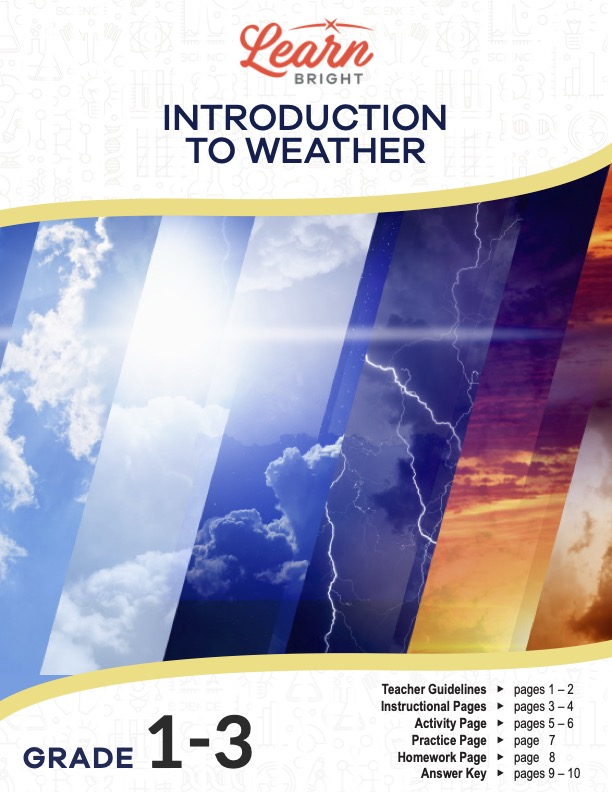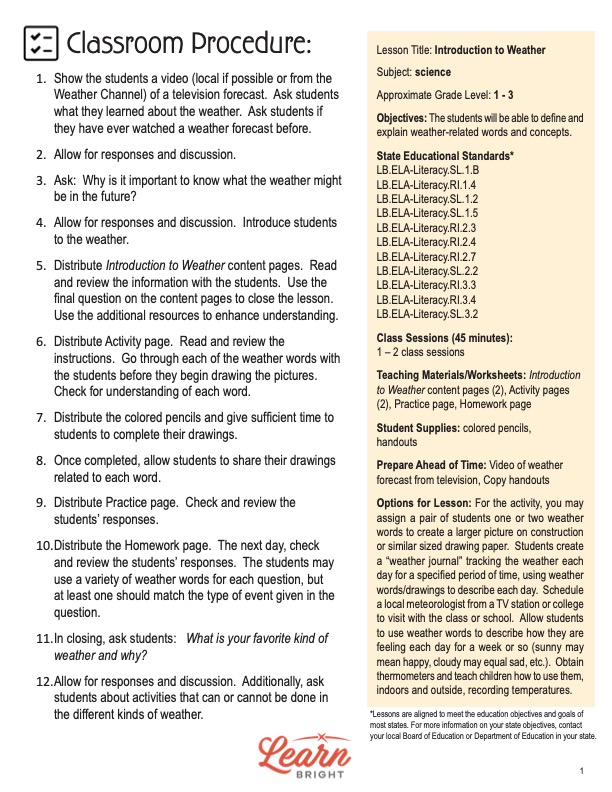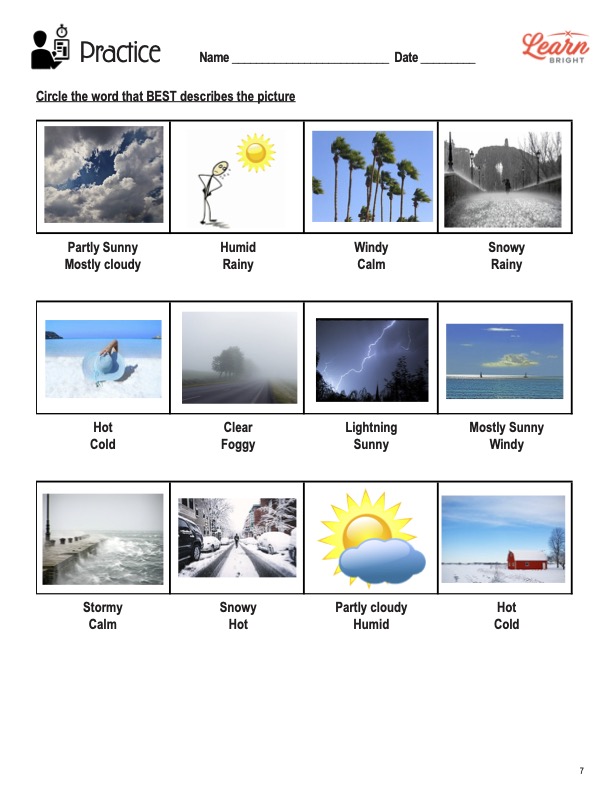Description
What our Introduction to Weather lesson plan includes
Lesson Objectives and Overview: Introduction to Weather teaches students about the various factors that affect what it feels like outdoors in different places. Students will learn about temperature, humidity, air pressure and wind speed. They will also discover that an area’s distance from the equator also affects the weather there. This lesson is for students in 2nd grade and 3rd grade.
Classroom Procedure
Every lesson plan provides you with a classroom procedure page that outlines a step-by-step guide to follow. You do not have to follow the guide exactly. The guide helps you organize the lesson and details when to hand out worksheets. It also lists information in the yellow box that you might find useful. You will find the lesson objectives, state standards, and number of class sessions the lesson should take to complete in this area. In addition, it describes the supplies you will need as well as what and how you need to prepare beforehand. Colored pencils are the only supplies you will need in addition to the handouts for this lesson.
Options for Lesson
In the “Options for Lesson” section of the classroom procedure page, you will find several suggestions for additional activities or alternate ways to approach the lesson. One idea relates to the activity specifically and suggests that you can assign pairs of students one or two weather words to draw pictures for. Instead of creating pictures for all of the words on the worksheet, they could use larger drawing paper or construction paper so that they can create bigger images. Students could also create a journal to track the weather for each day for a specific amount of time and use words and pictures to describe each day. Another idea is to invite a local meteorologist from a TV station or college to visit with the class and answer their questions. You could also allow students to use weather-related words to describe their feelings every day for a week or so. For example, sunny could mean happy or cloudy could mean sad. One final idea is to get some thermometers and teach the students how to use them to record the temperature, both inside and outside.
Teacher Notes
The paragraph on this page gives you additional insight or information about the lesson plan and what you can expect from it. It suggests briefly discussing the difference between climate and weather. You can use the blank lines to write down your ideas as you prepare the lesson for your students.
INTRODUCTION TO WEATHER LESSON PLAN CONTENT PAGES
Weather and the Atmosphere
The Introduction to Weather lesson plan contains two content pages. To start off, the lesson mentions how the weather is a common topic of conversation among many adults. It’s also possible that students wonder about the weather when it comes to recess time. Weather describes what it is like outside at any given time of day. It could be cold, hot, wet, dry, clear, cloudy, calm, or stormy.
Around the earth is a layer of gases that make up the atmosphere. This is where the changes in weather take place. The atmosphere acts as a shield that protects the earth and the things living on it. It also keeps the earth at a safe temperature. Students will learn that a person who studies and predicts the weather is called a meteorologist.
Temperature and Humidity
The temperature outside helps us know how hot or cold the air is. The motion of energy in the air and the speed of air molecules determine the temperature. The faster gas molecules in the air move, the warmer it will feel outside. A thermometer measures the temperature, and the units are called degrees. If the temperature is 32°F, that means the air has reached freezing, meaning water can turn into ice or it might snow.
How wet or dry we feel outside relates to the humidity in the air. Humidity tells us the amount of moisture or water vapor present in the air. This is the water we cannot see. However, we can feel it, especially when it’s warm outside. The higher the humidity, the more likely it is that we will sweat. If there is too much water vapor in the air, it will begin to rain.
Air Pressure and Wind
Air pressure determines whether or not the weather shows clear or cloudy skies. It is the weight of the atmosphere pressing down on the earth. Another name for air pressure is atmospheric pressure. Along with humidity, air pressure affects all parts of the weather each day. To measure it, we use a tool called a barometer. There are two types of air pressure: high and low. High pressure is usually connected with fair and sunny weather. Low pressure normally brings clouds and rain or snow. Areas with really low air pressure will likely experience thunderstorms.
Whether the weather is calm or stormy depends on the wind. Wind is the air moving from higher pressure areas to lower pressure areas. An anemometer measures air speed or wind speed. The heating of the earth’s surface, differences in air pressure, and the rotation of the earth all affect wind speed. In addition, the presence of mountains, vegetation, bodies of water, and other similar natural bodies can also affect wind speed. This is why some wind feels like a breeze at first but can change to strong winds in a few hours.
In addition to those four factors, the location of a place on earth affects the weather it will experience. Coastal regions will experience different weather than places near mountains. Typically, the weather along a coast will be warmer than areas around mountains. In addition, the closer we are to the equator, the warmer we will be.
INTRODUCTION TO WEATHER LESSON PLAN WORKSHEETS
The Introduction to Weather lesson plan includes three worksheets: an activity worksheet, a practice worksheet, and a homework assignment. Each one will help students solidify their grasp of the lesson content and demonstrate their knowledge in different ways. The guidelines on the classroom procedure page outline when to hand out each worksheet to your students.
DRAW THE WEATHER ACTIVITY WORKSHEET
For the activity, students will draw pictures to represent 12 different weather conditions, such as sunny, stormy, windy, and partially cloudy. The worksheet provides a box for each of the 12 settings. You may have students work in pairs or in small groups. You could also assign them a few conditions to draw images for on larger paper instead, as mentioned in the “Options for Lesson” section.
DESCRIBE THE PICTURE PRACTICE WORKSHEET
The practice worksheet requires students to review 12 images. Each one represents a specific type of weather conditions and lists two options below the picture. Students must circle the option that best describes the image.
INTRODUCTION TO WEATHER HOMEWORK ASSIGNMENT
There are two sections for the homework assignment. The first part requires students to match descriptions with the right term from the word bank. There are 15 descriptions, and the worksheet divides them into three groups of five statements. Each group has its own word bank for students to use. For the second section, students will answer five questions and use at least two weather-related words in their responses.
Worksheet Answer Keys
The final pages of the lesson plan document are answer keys for the practice and homework worksheets. All the correct answers are in red to make it easy to compare them to students’ work. For the most part, students’ answers should exactly reflect those on the keys, but there will be some variation on the second part of the homework assignment. If you choose to administer the lesson pages to your students via PDF, you will need to save a new file that omits these pages. Otherwise, you can simply print out the applicable pages and keep these as reference for yourself when grading assignments.










